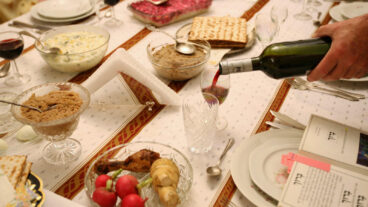Actors from Tel Aviv and New York, collaborate on a experimental theater project on the internet. (Photo: Gil Shapiro)As the minutes ticked down till performance time, Dr. Barbara Rose-Haum stood on the stage at New York University giving the cast and crew of her play Trespassing Boundaries last-minute instructions.
What made this different and far more technically complicated than the preparations for a typical stage performance was the large screen behind her – showing Dr. Sharon Aronson-Lehavi at Tel Aviv University, who was also preparing for the curtain to rise on the same play.
Only when both New York and Tel Aviv were both ready, the performance began.
On the darkened stage, New York actor Joe Wachs began reading the biblical story of the tower of Babel, while, on a screen behind him the New York audience could watch Tel Aviv actress Raheli Zinder drip honey on an open book, and read out Hebrew letters rhymically, synchronizing with the Wach’s narration. The Tel Aviv audience, watching Zinder live in front of them, could view the action from New York on a monitor behind her.
The experimental theater piece, performed simultaneously at NYU and TAU was a daring experiment in the potential of new media and Internet technology in the fine arts as a way of breaking down physical boundaries and allowing cross-cultural collaboration.
Throughout the performance, the actors’ lines and movements were intricately interwoven with one another.
There was also another audience that the actors could not see – the performance was streamed live over the Internet so that people around the world could view the performance piece on their own computers.
“This was really challenging collaboration because we were dealing with a medium that is so new to us. Unlike other art forms, there was no tradition to work for or against. And at the same time this was a collaboration of people who didn’t know each other before,” Rose-Haum told ISRAEL21c from New York. “In my work in New York, I normally work with people I’ve know for years.”
The joint project began with a bus ride in Singapore. Rose-Haum, a German-born assistant professor of Culture and Communication at NYU, and veteran of the New York art scene was attending a performing arts conference and while riding a bus from one conference location to another noticed that there were two Israelis next to her.
She struck up a conversation with them, during which she mentioned that she was interested in pursuing collaboration on an Internet 2 simultaneous performance with Israelis. Internet 2 technology is the next generation of interactive technology – a more sophisticated and higher quality level of video conferencing that has been embraced by the art world.
“I had no idea who these Israelis were,” she laughs as she recounts the story. “And it turned out that one of them was Prof. Freddie Rokem, the dean of Tel Aviv University’s School of Fine Arts.”
Roken was excited by her idea, and asked her, upon her return to New York, to meet with Aronson-Lehavi, a TAU graduate who was finishing her doctorate in theater studies at the City University of New York and about to return for post-doctoral work in Tel Aviv. The two women had a quick face-to-face meeting, but realized that they had a great deal in common – a shared academic and artistic interest in the way that biblical and other traditional texts are performed in contemporary culture and made relevant to today’s world.
Aronson-Lehavi’s academic work at CUNY, for which she had been awarded a Fulbright fellowship, focused on medieval and religious theater – examining avant-garde productions of Biblical and other texts.
Following their meeting in New York, Rose-Haum chose the texts she wanted to work with, and began emailing and speaking intensively with Aronson-Lehavi, who had returned to Israel. Together, they developed the project in a long-distance collaboration that they refer to as the “arranged marriage” set up by Rokem.
After the two women finalized the script, the collaborative work began in earnest.
“It started to take shape and we gathered our performers. We started having video conferences every other week – and that’s how our work continued – through email, Skype, and video conferences,” said Aronson-Lehavi.
Rose-Haum is a German born artist who has been living and working in New York City since the 1980s. The collaborative work with Israel comprised a portion of a series of performances she has done entitled Torn Texts.
Rose-Haum’s performances are meant to be an examination of how values are constructed through texts and the ritual repetition of words. Her method of making traditional readings of biblical texts contemporary while deconstructing them, includes intertwining them with newspaper clippings and fairy tales.
More akin to performance art than traditional theater, the “sets” in her work are actually installations are clusters of various objects. The Trespassing Boundaries set was designed to resemble a deserted archeological site, strewn with paper, stones and other objects.
Trespassing Boundaries focuses on the two biblical portions that are read according to the 2005 Jewish calendar during the week of November 10: the story of the tower of Babel and the conflict between Sarah and Hagar. It includes recounting the events of Kristallnacht, which took place during this week, and events in the Israeli-Palestinian conflict that happened during the same time. The five actors: Racheli Zinder and Shredi Jebarin – an Israeli Arab – in Tel Aviv, and Joe Wachs, Nadine Campeau, Ann George performed the piece in three languages – English, Hebrew and Arabic.
The stated aim of the piece is “to recode and re-perform their mythical and therefore limiting systems of signification. The performance examines the cultural process of naming and stabilizing identities through language, and aims therefore to deconstruct and confuse language.”
The same idea is put more simply at the beginning of “Trespassing Boundaries: “In order to live in the world we must name it. Naming is the means by which we try to order and structure an undifferentiated mass. By naming we impose a pattern that allows us to manipulate the world. All naming is by necessity, biased. And the process of naming is one of encoding that bias.”
According to Rose Haum, the performance space should have no boundaries, thus inviting viewers to question their meaning and purpose and allowing for new meanings to emerge from texts which people presume to know and understand.
As Internet technology has progressed over the years, Rose Haum has harnessed and explored the potential of the new medium — previous pieces have been broadcast on the Internet, which she believes “serves as a site-less location, a non-place, in which artists from different locations and cultural backgrounds can collaborate and exchange their various cultural histories, memories, and gestures of renewal.”
Aronson-Lehavi says that Rose Haum’s work is characteristic of a very strong trend in today’s theater world, where the boundaries between theater and performance art have become blurred.
“The past 15 years has seen the rise of performance studies versus than traditional theater. It’s not just about telling a story that is disconnected and cut off from the audience — the audience is actively engaged and the actors do not necessarily play characters. This has been a very strong trend in New York in recent years.”
While Rose Haum has worked with the Internet before, its use was all new to Aronson-Lehavi, who found the Internet tools “complete magic” to members of the team like herself who were previously unfamiliar with it.
“Because I work in medieval texts, I wouldn’t have otherwise gotten close to new media, its opened up a whole new world for me,” she said.
Live internet broadcasts has been embraced by academia for several years, and many universities, including TAU have departments devoted to this kind of technology so that classrooms around the globe can communicate and researchers can share information and conduct joint experiments. Internet 2 enables users to broadcast live from more than one location, and the visual quality is higher than what had been available until now.
“The possibilities for the arts are only starting to be explored, and this is the first time that its been used in Israel for theater,” Aronson-Lehavi said.
In order to carry the project off, she had to work closely with the computer and technology staff of her university. Jack Barokas, the technician who provides internet services for Tel Aviv University, was intensively involved in every aspect of the production.
Barokas called it “a great experience, exciting and interesting because it is a new way to harness the technology.”
But technology has its limits. As the performance date drew nearer, Rose-Haum came to Israel in person to work with the performers.
“I’ve visited Israel before, but this was my most important visit to Israel. This time I developed a truly deep connection, and felt I was catapulted into the heart of it.”
Like any artist, she says she was not completely satisfied with the results. She notes says that to a large extent, she considers the work “unfinished” and said she would have like to work on it more, but “the downside of using the technology is that we had to do this in expensive rooms using expensive equipment, and so we can’t rehearse for as long as we’d like. In my opinion, the real collaboration only began to truly happen when we were in the actual space with the cameras, using the technology.”
The streaming version of the show is still available on the Internet – it can be seen at:
http://www.tau.ac.il/video/Lectures/Arts/Trespassing_Boundaries/
Rose-Haum cautions that those who view the performance on the Internet see far more of the Israeli show than the New York side.
“But this is a new technology and it is going to take time to perfect,” she said.
She doesn’t rule out coming back to this project or initiating a similar one in the future, “after we all rest after this one.” In the meantime, both Rose-Haum and Aronson-Lehavi are planning reflect and write about the experience.
Rose-Haum knows that she wants to continue working with Israelis. “Tel Aviv has a vivid art life and artists who impress me as being very engaged with the world.”












